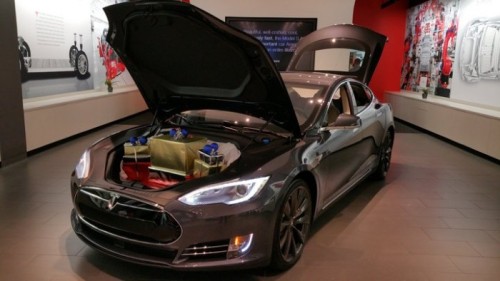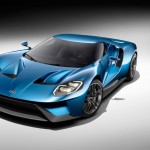Take a test drive. Stop reading this, go to a Tesla showroom, and sign up for a test drive. You’ll see that this car is: 1) Brutally quick. 2) Handsomely appointed. 3) Smarter than you, and 4) Will elevate the standard of what you should expect in a car. I took the Tesla Model S 85 out for a spin and I am smitten.
Performance
This car is no slouch. Elon Musk, Tesla’s co-founder, did the electric car’s second coming right with the Model S. The 85 variant, which is equipped with a 85 kWh battery and a single rear motor rated at 380 hp, can propel you to 60mph in a little over 5 seconds from a standstill. This performance is acceptable by today’s sports car standards, but realize that this agility has not been found in any other electric vehicle in production. Step up to the P85D, the performance dual motor variant, and you’re looking at almost a 700 hp rating. 0-60 in a little over 3 seconds. Electric vehicle or not, these figures will shake the boots of other luxury mainstays.
Push the pedal down and power is delivered to the wheels instantly. The Model S eagerly pulls off the line without delay thanks to the nature of electric motors. This battery laden, 4600 pound vehicle achieves maximum torque at zero RPMs which result in immediate response in acceleration. The single gear transmission coupled with the electric motor eliminates the gear-engine speed guessing game, providing the driver with optimal performance at any time.
Traditionally, power is delivered by completing the internal combustion engine cycle to transmit power to the wheels. A compressed air-fuel mixture is ignited producing mechanical work and transferred to the wheels via a fixed set of gears with different ratios. Thus, acceleration becomes a non-linear experience disturbed with gear changes that rob momentum. The internal combustion engine driving experience is further convoluted with the addition of forced induction as it depends more on engine speeds and air temperatures. The Tesla’s drivetrain is mechanically elementary in comparison and results in a highly efficient method of power delivery, a sensation that traditional cars try to emulate by increasing gear counts and additional clutches.
It’s important to point out what the lack of an internal combustion engine means and how much it affects you in the long run. The biggest life changing aspect of this car is the lack of having to do engine-based maintenance. “What is an oil-change?” our grandkids would ask. “When should I change my timing belt?”, “Should I change my spark plugs now or in another XX,XXX miles?” There is still maintenance that should be done, this is still a vehicle with mechanical components that wear and tear after all, such as the brakes. According to the Tesla employee I spoke with during the test drive, if you choose to do so you can bring your Model S once a year for around ~$600 for comprehensive inspection and peace of mind.
Not having an engine to lug around also creates a whole lot more room for compartments. The Model S has a trunk up front, a ‘frunk’ they call it, and a traditional hatchback design. No engine also means the lack of natural aspiration, which necessitates vents and various inlets for air intake and cooling purposes. The front fascia of the Model S is devoid of these air inlets, while the underside is largely flat thanks to the battery packs. In combination, these design features result in an extremely low coefficient of drag while maintaining a svelte, non-Prius like profile. Additionally, having no engine up front provides you with massive crumple zones. Thanks to this and the low rollover risk (due to the incredibly low center of gravity) this car has been deemed to be the safest car in the National Highway Traffic Safety Administration’s (NHTSA) history.
Interior
This love affair ends in the interior of the car. The materials in the Tesla S are ones you would find in an entry to mid-tier luxury sedan. The leather seats have a more modern look that matches the simple but elegant look of the entire car and it’s equipped with light bolstering that will fit a larger frame, however, insufficient for what the car can handle in the corners. The door panels and the dash are all fitted nicely and precise making for a very handsome and well put together look. The steering wheel feels nice to the touch and houses the only buttons you’ll find on the entire dash (besides the flashers and the glove box button)
The most distinctive feature in the interior is the 17″ touchscreen that centralizes all of the vehicles controls from driving control modes, suspension settings, temperature controls, music, navigation, etc. The high utility of this massive touchscreen avoids the need for buttons and knobs that freckle the dash of every car in history. The capacitive touchscreen provides a nice touch experience much like the glass surfaces found in today’s smartphones, though don’t expect the latest and greatest equipment here since the pixel density seems fairly low and it is not an OLED screen, which would produce sharper contrasts and deeper blacks.
This large screen becomes a huge source of light and can be quite distracting during night driving. Given that our eyes can tire from looking directly at a computer monitor during the workdays, it would be interesting to see what this screen would do over a period of 265 miles (claimed maximum travel capacity of the 85) of night driving. When you’re not looking at the massive touchscreen the digital instrument cluster displays the speedometer and the motor’s activity (whether you’re depleting or regenerating power), as well as a mini navigation screen and other useful trip and travel information.
It’s interesting to note that the navigation software in the main touchscreen area is handled by Google Maps while the navigation software beside the digital instrument cluster is handled by a version of Garmin. The information handoff between the two navigation softwares seem to work just fine, though time will tell what bugs will surface as maps receive updates.
Moving to the rest of the cabin you’ll find a cavernous space where a transmission tunnel would usually be found. The motor and transmission has been neatly packed near the rear axle area of the car, which create massive spaces for the consumer to put anything else in its place. This radical design in powertrain leads to a radical change in interior design philosophy. Without mechanical components that normally take up real estate, the interior of this car feels very much like an empty office space. This ‘office space’ is nicely equipped with lush leather, elegant faux wood panels, and lots of electronic gadgets, but overall it feels like you’re driving in an empty RV instead of a finely tuned sports sedan, where you’re typically cocooned by driver centric buttons and levers. Ultimately the interior is a matter of personal tastes. The Model S is a totally new form that followed a new function. Personally, I find the design to be sparse and flat out sleep-inducing.
Autopilot & Supercharger Network
Tesla’s movement toward self-driving cars is “Autopilot,” a nice one word summary of the system of systems that’s working in the car all at once. Autopilot combines the forward-looking camera, the car’s sonar system, radar, and real-time traffic updates to help you drive. The current state of Autopilot is several updates away from having a fully autonomous vehicle. Currently, you can have adaptive cruise control that can control the behavior of the car by the other cars around you. This means that you don’t have to touch the accelerator during stop and go traffic because it will do it for you. Soon Model S owners will be able to change lanes by only tapping on the turn signal stalks. No, they do not have to buy a new Model S to get this feature, they can simply connect their car to a wi-fi connection and get firmware updates. You are correct, the car is now your best and most impressive electronic gadget.
Without an energy delivery infrastructure the electric car is imprisoned to a finite area, simultaneously limiting its market appeal. The claimed 265 mile range of the 85 is a decent amount of range but is meaningless for cross country trips. Thankfully, the Supercharger network is steadily popping up in various regions of the country. An exciting proof of concept is the ability to swap the battery physically, allowing the driver to gain maximum range in about half the time it takes to fill up a tank of gas. Widespread adoption of electric vehicles is going to highly depend on successful integration of these charging and battery swap stations.
Final Thoughts
Leaving the test drive I found myself confused. On the one hand I was completely impressed by the performance and the overall automotive experience garnered by all of the electronic gadgetry. On the other I felt disdain for the car. Deep and utter hatred. Not because of its features but because it had invalidated my long held standards and beliefs of what a proper car should be. Before the Model S I would readily defend that the manual transmission is best and that the Dual-Clutch Transmission is a driver’s best lifehack. Before the Model S I would sympathize with both sides of the argument over naturally aspirated or forced induction. After the Model S I look back on these arguments and think about how we resemble chimpanzees beating our chests. The automotive world is in another league now and the standards have been elevated. It’s time we look forward and progress.











One Ping
Pingback:Things I’m Reading | Cartazzi :: Scott Johnson and AppData